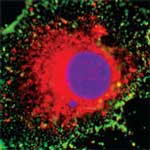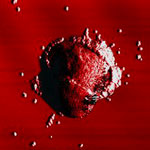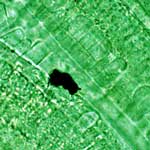Showing Spotlights 65 - 72 of 137 in category All (newest first):
 A group of researchers at the Technical University of Denmark have conducted a systematic analysis of 31 recently published reports and articles which discuss the environmental, health, and safety aspects of nanomaterials. They find that serious knowledge gaps pervade nearly all areas of basic nanotechnology EHS knowledge. These knowledge gaps or areas of uncertainty were ranked to how often they were included in the screened literature. The analysis found that the following areas in particular have been highly cited as important knowledge gaps within the field: the lack of reference materials and standardization; environmental fate and behavior; human and environmental toxicity; test methods to assess, particularly, the effects, and commercial or industrial-related aspects (e.g. life cycle assessments).
A group of researchers at the Technical University of Denmark have conducted a systematic analysis of 31 recently published reports and articles which discuss the environmental, health, and safety aspects of nanomaterials. They find that serious knowledge gaps pervade nearly all areas of basic nanotechnology EHS knowledge. These knowledge gaps or areas of uncertainty were ranked to how often they were included in the screened literature. The analysis found that the following areas in particular have been highly cited as important knowledge gaps within the field: the lack of reference materials and standardization; environmental fate and behavior; human and environmental toxicity; test methods to assess, particularly, the effects, and commercial or industrial-related aspects (e.g. life cycle assessments).
Jul 3rd, 2009
 You can find them in all kinds of products, from socks to food containers to coatings for medical devices - we are talking about silver nanoparticles. Valued for its infection-fighting, antimicrobial properties, silver in its modern incarnation as silver nanoparticles, has become the promising antimicrobial material in a variety of applications because the nanoparticles can damage bacterial cells by destroying the enzymes that transport cell nutrient and weakening the cell membrane or cell wall and cytoplasm. Despite their wide use, the issue of possible adverse effects and toxicity of nanoparticles for the human body is progressively, albeit slowly, recognized as central by an increasing number of studies. A widely accepted consensus on the detailed molecular mechanism of silver nanoparticles toxicity is still missing and very often the drive toward new formulations overwhelms the interest for a better assessment of the cytotoxicity of the nanoparticles. Scientists at the University of Trieste in Italy have now developed a novel non-cytotoxic nanocomposite hydrogel material based on natural polysaccharides and silver nanoparticles for antimicrobial applications.
You can find them in all kinds of products, from socks to food containers to coatings for medical devices - we are talking about silver nanoparticles. Valued for its infection-fighting, antimicrobial properties, silver in its modern incarnation as silver nanoparticles, has become the promising antimicrobial material in a variety of applications because the nanoparticles can damage bacterial cells by destroying the enzymes that transport cell nutrient and weakening the cell membrane or cell wall and cytoplasm. Despite their wide use, the issue of possible adverse effects and toxicity of nanoparticles for the human body is progressively, albeit slowly, recognized as central by an increasing number of studies. A widely accepted consensus on the detailed molecular mechanism of silver nanoparticles toxicity is still missing and very often the drive toward new formulations overwhelms the interest for a better assessment of the cytotoxicity of the nanoparticles. Scientists at the University of Trieste in Italy have now developed a novel non-cytotoxic nanocomposite hydrogel material based on natural polysaccharides and silver nanoparticles for antimicrobial applications.
Jun 29th, 2009
 From a risk and safety point of view it is impossible to draw any definite conclusions as far as today's nanomaterials are concerned. Although gaining steam, nanotoxicological research is still scarce; standards are just emerging; and scientific findings can be contradicting each other because the underlying assumptions and methodologies vary. One initiative that tried to shed light on this issue is a recently completed global review of completed and near completed environment, health and safety research on nanomaterials and nanotechnology. The resulting EMERGNANO report is a unique attempt to identify and assess worldwide progress in relation to nanotechnology risk issues. The review doesn't provide any new data or conclusions but is offeres a fairly comprehensiv identification, stocktaking and analysis of of research carried out worldwide on nanotechnology safety, including that relating to hazard, exposure, risk assessment and regulation.
From a risk and safety point of view it is impossible to draw any definite conclusions as far as today's nanomaterials are concerned. Although gaining steam, nanotoxicological research is still scarce; standards are just emerging; and scientific findings can be contradicting each other because the underlying assumptions and methodologies vary. One initiative that tried to shed light on this issue is a recently completed global review of completed and near completed environment, health and safety research on nanomaterials and nanotechnology. The resulting EMERGNANO report is a unique attempt to identify and assess worldwide progress in relation to nanotechnology risk issues. The review doesn't provide any new data or conclusions but is offeres a fairly comprehensiv identification, stocktaking and analysis of of research carried out worldwide on nanotechnology safety, including that relating to hazard, exposure, risk assessment and regulation.
Jun 16th, 2009
 There is a slowly growing body of work that investigates the toxicity of synthesized nanoparticles to plants, aquatic invertebrates, algae, bacteria and different cell lines and we have been covering this topic in previous Spotlights as well as our nanoRISK newsletter. Although the potential negative effects of nanoparticles on organisms and the environment have raised concerns, limited studies so far have examined the difference between nanoparticles and bulk particles with the same chemical composition and mineral phase, or addressed the toxicity of dissolved metal ions from the nanoparticles. In new work by scientists at the University of Massachusetts, the toxicity of bulk oxide particles and the released ions were assessed along with four oxide nanoparticles, which clearly showed that size matters.
There is a slowly growing body of work that investigates the toxicity of synthesized nanoparticles to plants, aquatic invertebrates, algae, bacteria and different cell lines and we have been covering this topic in previous Spotlights as well as our nanoRISK newsletter. Although the potential negative effects of nanoparticles on organisms and the environment have raised concerns, limited studies so far have examined the difference between nanoparticles and bulk particles with the same chemical composition and mineral phase, or addressed the toxicity of dissolved metal ions from the nanoparticles. In new work by scientists at the University of Massachusetts, the toxicity of bulk oxide particles and the released ions were assessed along with four oxide nanoparticles, which clearly showed that size matters.
Apr 16th, 2009
 NIOSH, the National Institute for Occupational Safety and Health in the United States, has published the final version of its report 'Approaches to Safe Nanotechnology'. This document reviews what is currently known about nanoparticle toxicity, process emissions and exposure assessment, engineering controls, and personal protective equipment. This updated version of the document incorporates some of the latest results of NIOSH research, but it is only a starting point. The document serves a dual purpose: it is a summary of NIOSH's current thinking and interim recommendations; and it is a request from NIOSH to occupational safety and health practitioners, researchers, product innovators and manufacturers, employers, workers, interest group members, and the general public to exchange information that will ensure that no worker suffers material impairment of safety or health as nanotechnology develops.
NIOSH, the National Institute for Occupational Safety and Health in the United States, has published the final version of its report 'Approaches to Safe Nanotechnology'. This document reviews what is currently known about nanoparticle toxicity, process emissions and exposure assessment, engineering controls, and personal protective equipment. This updated version of the document incorporates some of the latest results of NIOSH research, but it is only a starting point. The document serves a dual purpose: it is a summary of NIOSH's current thinking and interim recommendations; and it is a request from NIOSH to occupational safety and health practitioners, researchers, product innovators and manufacturers, employers, workers, interest group members, and the general public to exchange information that will ensure that no worker suffers material impairment of safety or health as nanotechnology develops.
Apr 7th, 2009
 Most of the nanotoxicology research currently undertaken deals with the potential risk aspects that various nanomaterials might pose for the human body. So far, the mechanisms of nanoparticle phytotoxicity - the ability to cause injury to plants - remain largely unknown and little information on the potential uptake of nanoparticles by plants and their subsequent fate within the food chain is available. Research in this area is fairly scant, and among the few studies available, none have used major food crops or carbon nanoparticles. The interaction between nanoparticles and plants currently is poorly understood. Unlike mammalian species, plants have thick and porous cell walls and a vascular system for water and nutrients uptake. Plants in natural environment can also conduct photosynthesis. How nanoparticle uptake and their accumulation may impact on plant structure and their biological and biochemical processes remains a question. The few studies available in this field are probably only touching the tip of the iceberg. A team of scientists at Clemson University has now undertaken an effort to shed light on the impact of nanomaterials on high plants, filling a significant knowledge gap in the current literature.
Most of the nanotoxicology research currently undertaken deals with the potential risk aspects that various nanomaterials might pose for the human body. So far, the mechanisms of nanoparticle phytotoxicity - the ability to cause injury to plants - remain largely unknown and little information on the potential uptake of nanoparticles by plants and their subsequent fate within the food chain is available. Research in this area is fairly scant, and among the few studies available, none have used major food crops or carbon nanoparticles. The interaction between nanoparticles and plants currently is poorly understood. Unlike mammalian species, plants have thick and porous cell walls and a vascular system for water and nutrients uptake. Plants in natural environment can also conduct photosynthesis. How nanoparticle uptake and their accumulation may impact on plant structure and their biological and biochemical processes remains a question. The few studies available in this field are probably only touching the tip of the iceberg. A team of scientists at Clemson University has now undertaken an effort to shed light on the impact of nanomaterials on high plants, filling a significant knowledge gap in the current literature.
Mar 5th, 2009
 A new PhD dissertation 'Regulation and Risk Assessment of Nanomaterials - Too Little, Too Late?' by Steffen Foss Hansen from DTU Environment at the Technical University of Denmark finds that key pieces of the current European legislation are inadequate when it comes to regulating nanomaterials in the short and the long term. Hansen furthermore finds that the chemical risk assessment framework is inadequate to timely inform policy-makers about the health and environmental risks of nanomaterials, if not in the short term, then most definitely, in the long term. The aim of the PhD dissertation was threefold: 1) Investigate whether existing regulation is adequate in the short and the long term, 2) Explore the feasibility of risk assessment for the purpose of dealing with the complex emerging risks of nanomaterials and finally; 3) Provide recommendations on how to govern nanotechnologies.
A new PhD dissertation 'Regulation and Risk Assessment of Nanomaterials - Too Little, Too Late?' by Steffen Foss Hansen from DTU Environment at the Technical University of Denmark finds that key pieces of the current European legislation are inadequate when it comes to regulating nanomaterials in the short and the long term. Hansen furthermore finds that the chemical risk assessment framework is inadequate to timely inform policy-makers about the health and environmental risks of nanomaterials, if not in the short term, then most definitely, in the long term. The aim of the PhD dissertation was threefold: 1) Investigate whether existing regulation is adequate in the short and the long term, 2) Explore the feasibility of risk assessment for the purpose of dealing with the complex emerging risks of nanomaterials and finally; 3) Provide recommendations on how to govern nanotechnologies.
Mar 4th, 2009
 Silver has long been recognized for its infection-fighting properties and it has a long and intriguing history as an antibiotic in human health care. In ancient Greece and Rome, silver was used to fight infections and control spoilage. In its modern form, silver nanoparticles have become the promising antimicrobial material in a variety of applications because they can damage bacterial cells by destroying the enzymes that transport cell nutrient and weakening the cell membrane or cell wall and cytoplasm. For instance, an increasingly popular applications is to use pure silver, or silver-coated, nanoparticles in food packaging materials such as plastic bags, containers, films or pallet. A new study has found that silver nanoparticles can bind with double-stranded DNA and, possibly in this way, result in compromised DNA replication fidelity both in vitro and in vivo. But the study could not conclusively determine whether silver nanoparticles directly interact with DNA polymerases.
Silver has long been recognized for its infection-fighting properties and it has a long and intriguing history as an antibiotic in human health care. In ancient Greece and Rome, silver was used to fight infections and control spoilage. In its modern form, silver nanoparticles have become the promising antimicrobial material in a variety of applications because they can damage bacterial cells by destroying the enzymes that transport cell nutrient and weakening the cell membrane or cell wall and cytoplasm. For instance, an increasingly popular applications is to use pure silver, or silver-coated, nanoparticles in food packaging materials such as plastic bags, containers, films or pallet. A new study has found that silver nanoparticles can bind with double-stranded DNA and, possibly in this way, result in compromised DNA replication fidelity both in vitro and in vivo. But the study could not conclusively determine whether silver nanoparticles directly interact with DNA polymerases.
Feb 19th, 2009
 A group of researchers at the Technical University of Denmark have conducted a systematic analysis of 31 recently published reports and articles which discuss the environmental, health, and safety aspects of nanomaterials. They find that serious knowledge gaps pervade nearly all areas of basic nanotechnology EHS knowledge. These knowledge gaps or areas of uncertainty were ranked to how often they were included in the screened literature. The analysis found that the following areas in particular have been highly cited as important knowledge gaps within the field: the lack of reference materials and standardization; environmental fate and behavior; human and environmental toxicity; test methods to assess, particularly, the effects, and commercial or industrial-related aspects (e.g. life cycle assessments).
A group of researchers at the Technical University of Denmark have conducted a systematic analysis of 31 recently published reports and articles which discuss the environmental, health, and safety aspects of nanomaterials. They find that serious knowledge gaps pervade nearly all areas of basic nanotechnology EHS knowledge. These knowledge gaps or areas of uncertainty were ranked to how often they were included in the screened literature. The analysis found that the following areas in particular have been highly cited as important knowledge gaps within the field: the lack of reference materials and standardization; environmental fate and behavior; human and environmental toxicity; test methods to assess, particularly, the effects, and commercial or industrial-related aspects (e.g. life cycle assessments).
 Subscribe to our Nanotechnology Spotlight feed
Subscribe to our Nanotechnology Spotlight feed





